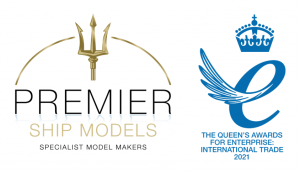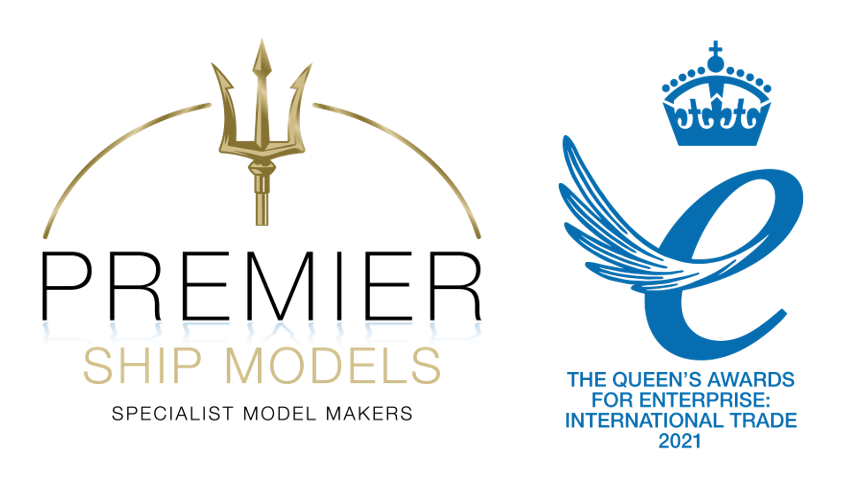A Little About Us
Premier Ship Models is a Corporate Professional Ship Model building company based in London. Successfully delivered over 300 Customised Ship Models to a global clientele spanning 50 countries during the last 17 years. Collaborative working with our clientele and technical staff has enabled Customised Ship Models to be built using a range of ‘Collective Services;’ Scale Ship Models to Desktop Ship Models, 3D Printing, Virtual Reality, Restoration, Rebranding and Refitting, Display Cases & Valuation Services. Our skilled colleagues use a variety of different techniques, modern methods and the latest technology to create that inspirational customise ship model.
We have just completed a custom build of the General Frisbie steamship, measuring 32 inches in length.
As stated above, the General Frisbie was a wooden two-deck passenger steamship constructed in 1900 and named after John B. Frisbie. Originally designed as a ferry to operate between Vallejo and San Francisco, the vessel was highly successful in its early years, becoming the fastest ship on the route at the time of its launch. However, advancements in infrastructure, including improved roads, bridges, and the rise of automobiles, led to a decline in demand for ferry services across the San Francisco Bay Area. By the late 1920s, newer ferries designed to transport vehicles had rendered the General Frisbie obsolete, and the ship was subsequently retired.
In 1930, the vessel was sold and transported to Seattle, where it was renamed Commander. From 1931, it operated as a ferry between Bremerton and Seattle, albeit in a reduced capacity as a budget alternative with limited capabilities, particularly for carrying cars. This marked a shift from the superior service it had provided in San Francisco. The ship continued operating until November 1935, when its ownership was acquired during a ferry workers’ strike, prompting its immediate retirement from ferry service.
In 1936, the ship was repurposed as a floating salmon cannery. During the fishing seasons of 1937 and 1938, it travelled to Moser Bay on Kodiak Island, Alaska, returning to Seattle each autumn with canned salmon. By 1939, its engine and fittings were removed, and the hull was towed back to Moser Bay, where it was beached in 1940 to serve as part of a land-based cannery. A decade later, in 1950, the vessel was fully dismantled, bringing an end to its long and varied service history.
This project was commissioned by a private client in the United States, requiring discretion regarding specific details.
The client was thoroughly impressed with the finished model of the General Frisbie steamship. They commended the project for its effective and transparent communication at every stage, as well as the efficiency in meeting deadlines. The successful delivery was particularly noteworthy given the intricacies involved in coordinating an international project of this nature.
The model was expertly handcrafted using timber, acrylic, and fibreglass, with detailed chrome accents providing a polished finish. Measuring 32 inches in length, the model was designed with exceptional precision and attention to detail, though it does not include moving parts, internal mechanisms, or lighting.
CNC machinery was employed for crafting smaller elements such as railings, deck stairs, windows, and life rings, but the majority of the construction was completed by hand.
The project spanned approximately ten months to complete. The payment schedule was structured as follows: an initial 50% deposit was made at the start, followed by a further 30% upon near completion, with the remaining 20% settled upon delivery. The total cost included a custom wooden packing case, purpose-built to protect the model during transit and ensure its safe arrival.
The General Frisbie model was predominantly handcrafted using timber, fibreglass, acrylic, and chrome detailing, exemplifying outstanding craftsmanship and meticulous attention to detail.
Before construction began, all agreements with the client were clearly defined. This included specifications for dimensions, design, aesthetic preferences, financial arrangements, and the project timeline. These measures ensured full transparency and minimised the risk of misunderstandings.
The process commenced with the construction of the hull, the foundational element of any ship model. It was carefully measured and crafted to exact specifications. Once the hull was complete, work transitioned to the upper deck, where small wooden planks were painstakingly attached to the sides of the ship, gradually concealing the internal framework. Structural supports for the stacks and main cabins were then installed.
The painting stage followed, where the hull, deck, and intricate details were finished with precision. The lower hull was painted a rich crimson, accented with black and green stripes for added authenticity. The remainder of the ship was finished in crisp white, and a ‘Commander’ decal was applied both towards the stern and on the bridge.
In the final stages, the model underwent a comprehensive cleaning and polishing process. Windows received touch-ups, railings were polished, and life rings were securely attached to said railings. The model was then mounted on a custom wooden base, providing a professional and elegant presentation to complete the project.
The client was highly impressed with the finished model, praising its extraordinary craftsmanship and intricate detailing. The logistics of shipping and delivery were executed without issue, ensuring the model reached its destination in perfect condition and ready for immediate display.
This project was a rewarding opportunity to recreate a historic vessel in exquisite detail, and we look forward to taking on new challenges in the creation of bespoke models in the future!
Commission your own model
If you would like to have your own bespoke model built, please complete the contact form below.


